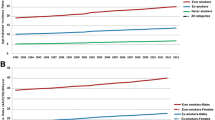Abstract
In a background of changing lung cancer rates in the past decade, mean incidence and mortality rates for persons aged 25–44 in Tasmania for the decade 1983 through 1992 were examined using Tasmanian Cancer Registry data. The smoking behavior of Tasmanian adults and schoolchildren was also investigated, using data from a social survey conducted by the Australian Bureau of Statistics and from five secondary school smoking surveys. The Tasmanian age-standardized lung cancer incidence rates in 25–44 year olds for the 10-year period were 6.2 per 100,000 females and 3.3 per 100,000 males. Mean rates of incidence were higher for females than for males (P=0.02). The corresponding mortality rates were 4.2 in females and 2.4 in males (P=0.08). The prevalence of smoking by adult Tasmanian women is higher than that for other Australian women (P<0.05), and their duration of smoking is longer (P<0.01). Tasmanian schoolgirls have a higher smoking prevalence than Australian mainland schoolgirls (P=0.01) and higher prevalence than Tasmanian schoolboys (P=0.01). The data suggest that smoking prevalence among teenagers passed that for males only a decade before the observed excess of female incident cases among 25–44 year olds in Tasmania.
Similar content being viewed by others
References
Giles GG, Hill DJ, Silver B. The lung cancer epidemic in Australia, 1910 to 1989.Aust J Public Health 1991;15: 245–7.
Shugg D, Dwyer T, Jones MJ, eds.Cancer in Tasmania: Incidence and Mortality 1987. Hobart, Tasmania (Australia): Menzies Centre for Population Health Research, 1990: 14–17.
Holman CDJ, Armstrong BJ.Cancer Mortality Trends in Australia 1910–1976. Perth, Australia: Cancer Council of Western Australia, 1982: p. 231.
Holman CD, Harton WM, Armstrong BK, English DR.Cancer Mortality Trends in Australia, Volume II, 1910–1984. Perth, Australia: Health Department of Western Australia, 1987, 72–3.
Centers for Disease Control. Trends in lung cancer incidence and mortality—United States 1980–1987.MMWR 1990;39: 875–83.
Davis DL, Hoel D, Fox J, Lopez A. International trends in cancer mortality in France, West Germany, Italy, Japan, England and Wales and the USA.Lancet 1990;336: 474–81.
Waldron I. Recent trends in sex mortality ratios for adults in developed countries.Soc Sci Med 1993;36: 451–62.
Doll R, Peto R.The Causes of Cancer: Quantitative Estimates of Avoidable Risks of Cancer in the United States Today. New York, NY (US): Oxford University Press, 1981: 1292–300.
Zang EA, Wynder EL. Cumulative tar exposure: a new index for estimating lung cancer risk among cigarette smokers.Cancer 1992;70: 69–76.
Hill DJ, White VM, Gray NJ. Australian patterns of tobacco smoking in 1989.Med J Aust 1989;154: 797–801.
Doll R. Progress against cancer: an epidemiological assessment.Am J Epidemiol 1991;134: 675–88.
Devesa SS, Blot WJ, Fraumeni JF Jr. Declining lung cancer rates among young men and women in the United States: a cohort analysis.JNCI 1989;81: 1568–71.
Probert A, Morrison H, Semenciw R, Mao Y. Recent trends in lung cancer among Canadians ages 25–44.Can J Public Health 1992;83: 426–8.
Dinse GF, Hoel DG, Exploring time trends in cancer incidence.Cancer Causes Control 1992;3: 409–17.
World Health Organization.International Classification of Diseases, Ninth Revision. Geneva, Switzerland: WHO, 1975.
World Health Organization. International Classification of Diseases for Oncology. Geneva, Switzerland: WHO, 1975.
Boyle P, Parkin DM. Statistical methods for registries. In: Jensen OM, Parkin DM, MacLennan R, Muir CS, Skeet RG, eds.Cancer Registration: Principles and Methods. Lyon, France: International Agency for Researchron Cancer 1991: 126–58.
McPherson G.Statistics in Scientific Investigation: Its Basis Application and Interpretation. New York, NY (US): Springer-Verlag, 1990: 479–81.
Giles G, Armstrong BK, Smith I.R., eds.Cancer in Australia 1982. Canberra, Australia: National Cancer Statistics Clearing House, 1987: p. 82.
Jelfs P, Giles G, Shugg D, et al., eds.Cancer in Australia 1983–1985. Canberra, Australia: Australian Government Publishing Service, 1992: pp. 23, 71, 119.
Jelfs P, Giles G, Shugg D, et al, eds.Cancer in Australia 1986–1988. Canberra, Australia: Australian Government Publishing Service, 1994: pp. 42, 100, 158.
Australian Bureau of Statistics.1989–90 National Health Survey Users' Guide, cat. 4363.0. Canberra, Australia: Commonwealth Government Printer, 1991.
Woodward SD. Trends in cigarette consumption in Australia.Aust NZ J Med 1984;14: 405–7.
Hill DJ. Australian patterns of tobacco smoking in 1986.Mead J Aust 1986;149: 6–10.
Glover J, Woolacott T, eds.Social Health Atlas of Australia. Canberra, Australia: Commonwealth Department of Health Housing & Community Services and South Australian Health Commission, 1992.
Hill DJ, White VM, Williams RM, Gardner GJ. Tobacco and alcohol use among Australian secondary school students in 1990.Med J Aust 1993;158: 228–34.
Dixon BHS, Clements FW, Cullen J, et al, eds.Smoking Habits of Australian Schoolchildren—NH & MRC Smoking Survey Results. Canberra, Australia: Australian Government Publishing Service, 1979.
SAS Institute Inc.SAS/STAT User's Guide, Version 6, 4th Ed, Volume 2. Cary, NC (US): SAS Institute Inc. 1989.
Carr DT. Histopathology of lung cancer.Int J Epidemiol 1990;19 (Suppl): S8-S10.
Fiori MC, Novotny TF, Pierce JP, Hatziandreu EJ, Patel KM, Davis RM. Trends in cigarette smoking in the United States: the changing influence of gender and race.JAMA 1989;261: 49–55.
Hill DJ, White WM, Gray NJ: Measures of tobacco smoking in Australia 1974–1986 by means of a standard method.Med J Aust 1988;149: 10–12.
Doll R, Gray R, Hafner B, Peto R. Mortality in relation to smoking: 22 years' observations in female British doctors.Br Med J 1980;280: 967–71.
Risch HA, Howe GR, Jain M, Burch JD, Holowaty EJ, Miller AB. Are female smokers at higher risk of lung cancer than male smokers? A case control analysis by histologic type.Am J Epidemiol 1993;138: 281–93.
Author information
Authors and Affiliations
Additional information
This project is funded partially by the Tasmanian Department of Community and Health Services in the form of an annual grant for the operation of the Tasmanian Cancer Registry.
Rights and permissions
About this article
Cite this article
Dwyer, T., Blizzard, L., Shugg, D. et al. Higher lung cancer rates in young women than young men: Tasmania, 1983 to 1992. Cancer Causes Control 5, 351–358 (1994). https://doi.org/10.1007/BF01804986
Received:
Accepted:
Issue Date:
DOI: https://doi.org/10.1007/BF01804986



